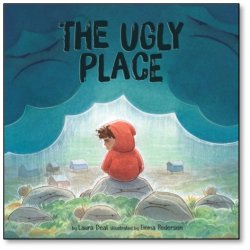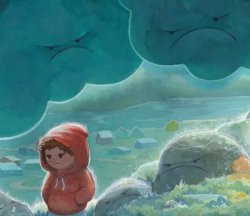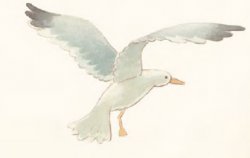
The Ugly Place by Laura Deal, illustrated by Emma Pedersen
Nunavut: Inhabit Media Inc., 2022
Reviewed by Samantha Piede
In Irish philosopher Iris Murdoch’s essay “The Sovereignty of Good Over Other Concepts,” she warns readers of the plight of the human ego: that, as “anxiety-ridden animals” (1970, p. 82), we are prone to centering our selfish cares in ways that obscure our understanding of reality. We forget that the universe does not begin and end with our struggles. We need moments of ‘unselfing’ – moments when we are jolted out of our own cares and reorient ourselves to see the world for what it is. In the essay, Murdoch recounts a moment in her own life when she found herself recentered. She describes a time in which she found herself in an “anxious and resentful state of mind” (1970, p. 82) until her eye is captured by a fluttering outside her window: a hovering kestrel. For a moment, she is arrested: “In a moment everything is altered. The brooding self with its hurt vanity has disappeared. There is nothing now but kestrel” (1970 p. 82). The encounter does not last long, but, when her attention shifts back to her troubles, they suddenly appear smaller and less vital. This encounter with nature, it seems, was enough to temporarily release her from the hold of her ego.
The protagonist of Laura Deal’s 2022 release, The Ugly Place – a small child in a red hoodie – is in an equally foul mood, one that appears unlikely to subside on its own. Grouchy and frustrated, they do what they always do when they feel this way: trudge along the Arctic coastline and visit what they call their “Ugly Place.” The only way to get there, they tell readers, is if you are “absolutely miserable,” so they slam their hands into their pockets and set off grumpily.

The child stomps along the shoreline, repeating an “ugly” refrain. The weather, they tell us, is “ugly.” The rocks are “ugly.” The fish are “ugly.” Even the child’s movements are ugly. They “trash and splash through the tide pools,” forcing frightened snails to take cover, and they “kick at the puddles.” Illustrator Emma Pedersen capitalizes on the repugnance, rendering the beach in muddy browns and dismal greys. The illustrations of the rocks and clouds seem too to mirror the child’s mood as Pederson twists their curvatures into grumpy frowns.

For a moment, it feels like this dismal mood will last forever. Then, out of nowhere, a seagull glides across the skyline. The child notices it and, like Murdoch, is struck by its beauty: “Their crisp white feathers are exceptionally bright against the sunless sky.” The child’s “heart settles.” They remember to breathe, matching the rhythm of the tide – in and out, in and out. And, suddenly, everything changes. The sun’s light peeks through the clouds, and the child reveals that they begin to feel “more content.”
Suddenly, the beach transforms. The fish are no longer “ugly,” but instead friendly, “tossing water into the air to announce [the protagonist’s] arrival.” The breeze, once seemingly violent, now spins the child around as though they were dancing together. They imagine the sea worms as performing a slow waltz. The beach is no longer ugly, but, instead, startlingly beautiful. The child tells us, “The land and the sea remind me that there are many places to find beauty. Even in the ugliest conditions, we can make something beautiful together.”
One cannot help but consider the child’s encounter with the seagull in parallel with Murdoch’s kestrel: as moments when nature launches us out of ourselves and our petty complaints. It is the kestrel that pulls Murdoch away from her “brooding self” (Murdoch, 1970, p. 82). It is the seagull that reminds the child to breathe and reconsider their surroundings. Both Murdoch and Deal draw attention to the mystery of how encounters with nature disrupt our self-centeredness. What is it about the kestrel or the seagull – or a mountain, or waterfall, or a thunderstorm, or a sunset – that so adeptly launches us out of our petty concerns and forces us to reorient our thinking? And how does this reorientation happen in just a moment when no argument in the world could do quite the same thing?
Though the moments are brief and fleeting, many of us can recall moments when we were stopped dead in our tracks and experienced selfless awe – sometimes in nature, sometimes in art, sometimes in the beauty of another person. The inarticulacy of these moments may present an interesting philosophical struggle for both children and adults trying to capture these phenomena, for even the most precisely chosen words may fail to do justice to the experience. Still, the recognition that these moments are possible – and ethically significant – presents opportunities for rich discussion. What is the ethical import of engaging with these moments of natural awe? How do they help us to see more richly and more charitably? Teachers interested in Social-Emotional Learning (SEL) may also find rich resources in Deal’s text for giving students concrete ideas on how to calm their restless minds: heading into nature, controlling their breathing, and looking at the world from a new perspective.
Deal’s The Ugly Place does for children what Murdoch does for adults: highlight the importance of moments in which, through nature, we are reminded that we are not, in fact, the center of the universe – for it is more vast and beautiful than our anxieties.
